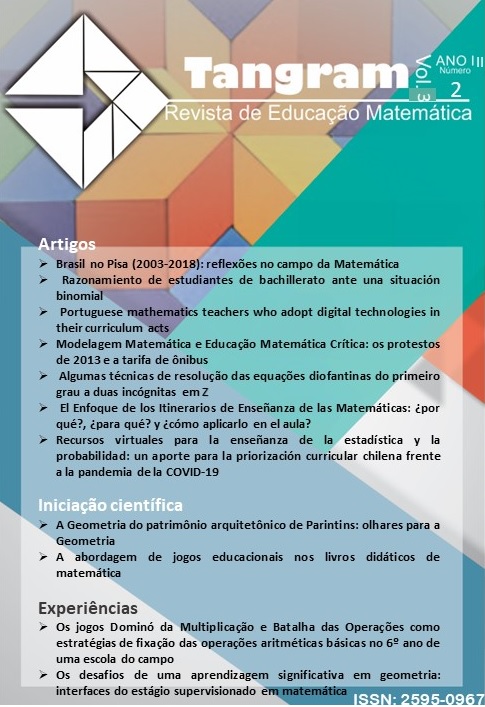Some techniques for solving the diophantine equations from the first degree to two unknowns in Z
DOI:
https://doi.org/10.30612/tangram.v3i2.11882Keywords:
Diophantine Equations. Mathematical Organizations. Teacher training.Abstract
This work aims to show techniques for solving Diophantine equations aiming at valuing the axioms, theorems and properties developed during the degree course in mathematics, such as, axiom of choice, Euclid's theorem, Bézout theorem, Gauss theorem, congruences etc. In this research, we consider that there are effective techniques for solving these equations that do not emerge in students' personal praxeologies. Within a qualitative perspective, we carried out an institutional analysis under the perspective of the Anthropological Theory of Didactics. Experimentation showed that there are techniques that students have the necessary knowledge to apply them. However, due to class practices, they favor the trial and error techniques, Euclid's Algorithm / Bézout's Theorem / Gauss's Theorem, although they were not always effective in obtaining solutions of first-degree Zlinear Diophantine equations. , it is necessary to reorganize and re-articulate students' knowledge so that they can expand their mathematical organizations so that they become effective in solving problems involving Diophantine equations.Downloads
References
Brasil (1999). Secretaria de Educação Média e Tecnológica do Ministério da Educação. Parâmetros Curriculares Nacionais para o Ensino Médio. Ciências
da Natureza, Matemática e suas tecnologias. Brasília: SEMT/ MEC.
Brasil (2009). Matriz de Referência para o ENEM. Brasília: Ministério da Educação.
Brasil (2017). Ministério da Educação. Base Nacional Curricular Comum: versão final. Secretaria da Educação Fundamental. Brasília, 2017. Disponível em: Acesso em: 18 de setembro.
Brousseau, G. (1996). Fundamentos e métodos da didática da matemática. In J. Brun. Didáctica das matemáticas. Lisboa: Horizontes Pedagógicos, Instituto Piaget.
Chachoua,H., & Bessot, A. (2019). La notion de variable dans le modèle praxéologique. Revista Educação Matemática e Pesquisa, 21(4), 234-247.
Ore, O. (1988). Number Theory and Its History. New York: Dover Publications Inc. Cap 6-8, p. 116-207.
Chevallard, Y. (1999). Analyse des pratiques enseignantes et didactique des mathématiques: L´approche anthropologique. Recherches en Didactique des Mathématiques, 19(2), 221-266.
Coelho, S.P., Machado, S.D.A., & Maranhão, M.C.S.A. (2003). Projeto: qual a
álgebra a ser ensinada em cursos de formação de professores de matemática? In Anais do II SIPEM, 29 out.- 1 nov. 2003 (pp. 1-19).
Costa, S. C. (2007). As equações diofantinas lineares e o Professor de matemática do ensino médio. Dissertação (Mestrado em Educação Matemática). Pontifícia Universidade
Católica de São Paulo.
Courant, R., & Robbins, H. (2000). O que é Matemática? (Adalberto da Silva Brito, Trad.). Rio de Janeiro: Ciência Moderna.
Fernandes, A.M.V., Avritzer, D. (2010). Fundamentos de Álgebra. Belo Horizonte: Editora UFMG.
Gascón, J. (2001). Incidencia del modelo epistemológico de las matemáticas sobre las prácticas docentes. Revista Latinoamericana de Investigación en Matemática Educativa (RELIME), 4(2), 129-159.
Gascón, J. (2011). Las tres dimensiones fundamentales de un problema didáctico: El caso del álgebra elemental. Revista Latinoamericana de investigación en Matemática Educativa, 14(2) , 203-231.
Groenwald, C.L.O., Sauer, L.O., Franke, R. F., Nunes, G.S., & Lautert, L.T.G.(s/d). Teoria dos Números e suas Aplicações no Processo de Ensino e Aprendizagem. Disponível em http://miltonborba.org/CD/Interdisciplinaridade/Encontro_Gaucho_Ed_Matem/cientificos/CC79.pdf. Acesso em 02 jun 2018.
Pommer, W. M., & Pommer, C. P. C. R. (2012). Equações diofantinas lineares: Um viés histórico/epistemológico como recurso para introduzir diferentes estratégias de
resolução de problemas. Revista de Ensino de Ciências e Matemática, 3, 28-42. Disponível em
http://revistapos.cruzeirodosul.edu.br/index.php/rencima/article/view/97.
Downloads
Published
How to Cite
Issue
Section
License
Authors must accept the publication rules when submitting the journal, as well as agree to the following terms:
(a) The Editorial Board reserves the right to make changes to the Portuguese language in the originals to maintain the cultured standard of the language, while respecting the style of the authors.
(b) Authors retain the copyright and grant the journal the right to first publication, with the work simultaneously licensed under the Attribution-NonCommercial-ShareAlike 3.0 Brazil (CC BY-NC-SA 3.0 BR) that allows: Share - copy and redistribute the material in any medium or format and Adapt - remix, transform, and create from the material. CC BY-NC-SA 3.0 BR considers the following terms:
- Attribution - You must give the appropriate credit, provide a link to the license and indicate whether changes have been made. You must do so under any reasonable circumstances, but in no way that would suggest that the licensor supports you or your use.
- NonCommercial - You may not use the material for commercial purposes.
- Sharing - If you remix, transform, or create from material, you must distribute your contributions under the same license as the original.
- No additional restrictions - You may not apply legal terms or technological measures that legally restrict others from doing anything that the license permits.
(c) After publication, authors are allowed and encouraged to publish and distribute their work online - in institutional repositories, personal page, social network or other scientific dissemination sites, as long as the publication is not for commercial purposes.






